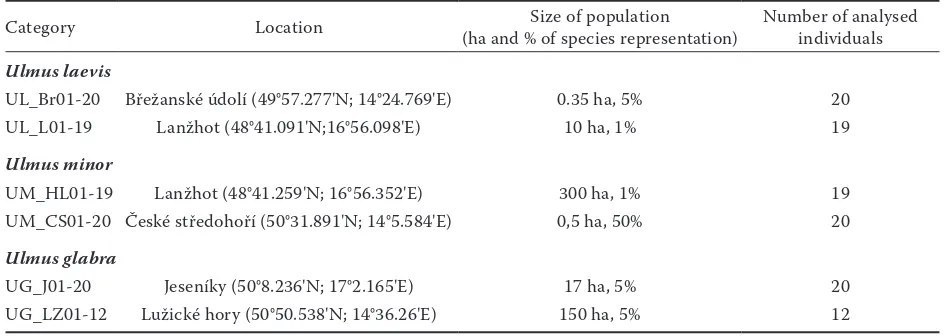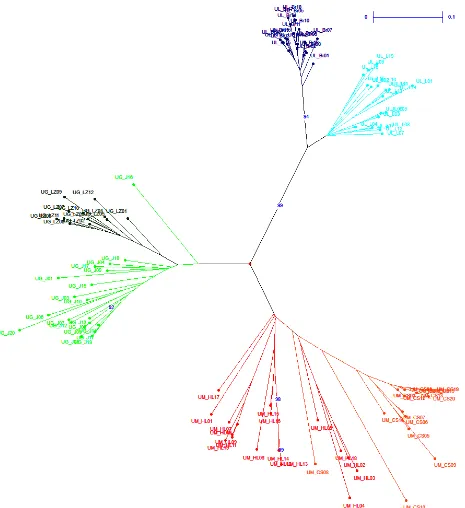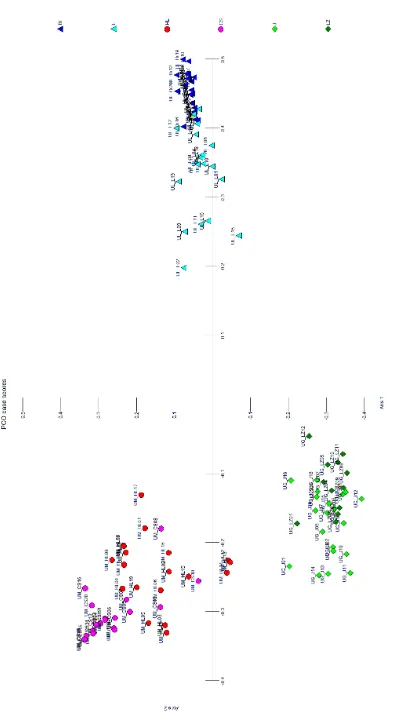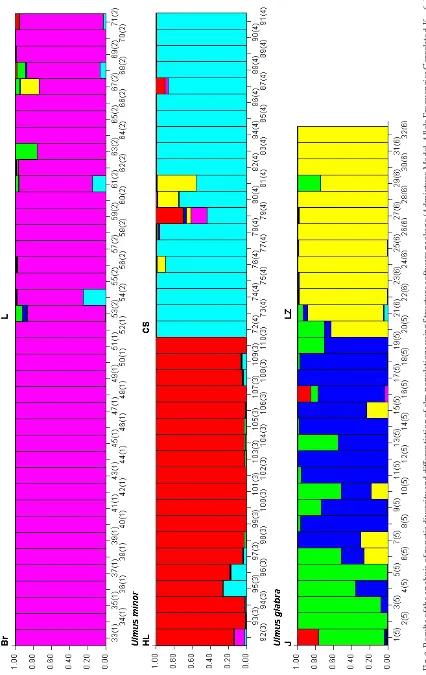Assessment of genetic variability in autochthonous elm
populations using ISSR markers
V. Čurn
1, M. Dědouchová
1, B. Kubátová
1, J. Malá
2, P. Máchová
2,
H. Cvrčková
21Biotechnological Centre, Faculty of Agriculture, University of South Bohemia in České Budějovice, České Budějovice, Czech Republic
2Forestry and Game Management Research Institute, Jíloviště, Czech Republic
ABSTRACT:Genetic diversity between 110 individuals from 6 elm populations (Ulmus minor, U. glabra and U. laevis) was determined using ISSR markers. Altogether 73 ISSR markers were evaluated with the average rate of polymorphic bands of 99.1%, which indicates high genetic diversity between the populations/species. The higher genetic diver-sity was revealed particularly in the population of U. glabra and this result was supported by the analysis of genetic diversity and differentiation of elm populations. Molecular analyses of ISSR markers allowed to assess the extent of genetic variability of native elm populations and characterize the levels of their genetic diversity and differentiation. Their further use can be seen in conservation and management activities.
Keywords: Ulmus minor; U. glabra; U. laevis; genetic diversity and differentiation; molecular markers
JOURNAL OF FOREST SCIENCE, 60, 2014 (12): 511–518
Elms are a group of tree species native to the tem-perate zone, treasured as a source of high quality wood but also highly valued as an important element of garden/urban and landscape architecture. Due to the good stress tolerance to environmental condi-tions such as air pollution, soil salinity, drought and floods elm is perfectly suited to urban plantings and due to the rich root system it belongs to the amelio-ration and stabilizing tree species. The importance of elms in maintaining genetic diversity of European forests is still considered a priority. Two international projects provide the co-ordination of conservation and assessment of the elm genetic resources in a Eu-ropean perspective: GENRES 78 project, carried out in 1997–2001 with the financial support of the Eu-ropean 32 Commission (EC), was focused on the ex situ conservation of elms, and The European Forest Genetic Resources Programme (EUFORGEN) pro-moting 34 conservation and sustainable utilisation of forest genetic resources in Europe, defined, along 35 with other forest tree species, conservation strategies for the European species of elms (Collin et al. 2004).
Elms (Ulmus minor, U. glabra and U. laevis) be-long to native tree species in the Czech Republic and in forest communities they have always represented a significant component of biocoenologial stability. Since the 1930’s, the elm population of U. minor and
U. glabra has suffered significant losses in their oc-currence and abundance due to an attack of the fungal disease known as Dutch elm disease (DED). A similar trend has been evident throughout the European con-tinent, resulting in the fragmentation of populations, reducing the frequency of elm in the environment and significant reduction of genetic variability (Cox et al. 2013).
Under the influence of the rapidly spreading dis-ease U. minor almost disappeared, while U. laevis has been affected to a lesser extent only (Collin 2002). In spite of the decline, U. glabra is still the most nu-merously occurring elm species in Central Europe. If we want not only to monitor the present state but also to predict the future development of the remnant populations of elms and realize their rescue, it will be necessary to obtain information about their genetic
variability. The reason is that the development of the natural population depends on the diversity of the genomes of individuals that created this population. Genetic diversity in forest trees, and also in elms, was studied by the analysis of isoenzymes (Ivanek et al. 2005), or more precisely by DNA approach (Wiegrefe et al. 1993; Whiteley et al. 2003; Cox et al. 2012).
The main aim of this study was to assess intra- and inter-population variability of selected autochtho-nous elm populations and to compare the extent of genetic variation in all three elm species using ISSR markers. Determination of Ulmus species based on ISSR fingerprints, verification of stability and resolu-tion capability of ISSR markers were another aims of this study.
MATERIAL AND METHODS
Plant material. One hundred and ten supposed
genotypes of elm were collected during 2011–2013 in six selected Czech autochthonous populations of
Ulmus minor, U. glabra and U. laevis (the list of samples and description of sites is given in Table 1). Selected populations are considered to be “core populations” in terms of conservation of the elm gene pool in the Czech Republic, and based on his-torical data and forest maps they are considered to be autochthonous. Selected populations were rep-resented by up to dozen individual trees, individu-als were selected randomly and all individuindividu-als were recorded. The sample size of approximately 20 indi-viduals per populations adequately represents the population, and even exceeds the size of the anal-ysed set of individuals used in studies where ISSR
markers were used (López-Aljorna et al. 2007; Cox et al. 2012; Nelson et al. 2014).
DNA isolation. Template DNA was extracted from
fresh or frozen material using the DNeasy Plant Mini Kit (QIAGEN). DNA was quantified in a Qbit fluo-rometer using the Qbit dsDNA BR assay kit (Invitro-gen Corporation, Carlsbad, CA) and stored at –20°C.
ISSR analysis. After initial screening of a wide
range of 30 ISSR primers from the University of Brit-ish Columbia, three primers generating the stable and repeatable pattern of markers were selected for ISSR analyses: UBC 807‒[AG]8T, UBC 810–[GA]8T, and 880–[GGAGA]3. PCR amplification reactions were carried out in the total volume of 10 μl containing 1× PPP Master Mix (Top-Bio), 12.5 pmol of primer, 1× BSA and 50 ng template DNA. Amplifications were performed using the following programme: pre-de-naturation for 2 min at 95°C, 40 cycles of 20 s at 93°C, 60 s annealing (UBC 807 55°C; UBC 810 48°C; UBC 880 51°C), and 20 s at 72°C, finally, 6 min at 72°C. PCR products were subjected to electrophoresis on 2% agarose gel in 1× TBE buffer containing ethidium bro-mide at 40 V for 20 min followed by 280 min at 80 V. Photographs of the gels were taken with UV transil-lumination using a Canon imaging system.
Band scoring and data analysis.All analyses were
performed in duplicate, and only samples with the same pattern of ISSR markers in both replicates were scored. Molecular data were analysed using digital image analysis and fingerprint patterns were trans-formed into a binary character matrix with 1 for pres-ence or 0 for abspres-ence of a band at a particular position in a lane. Genetic distance matrices were generated using Nei and Li (1979) metrics. This similarity ma-trix was employed to construct a dendrogram by the unweighted pair group method with arithmetical
av-Table 1. Set of analysed elm samples
Category Location (ha and % of species representation)Size of population Number of analysed individuals
Ulmus laevis
UL_Br01-20 Břežanské údolí (49°57.277'N; 14°24.769'E) 0.35 ha, 5% 20
UL_L01-19 Lanžhot (48°41.091'N;16°56.098'E) 10 ha, 1% 19
Ulmus minor
UM_HL01-19 Lanžhot (48°41.259'N; 16°56.352'E) 300 ha, 1% 19
UM_CS01-20 České středohoří (50°31.891'N; 14°5.584'E) 0,5 ha, 50% 20 Ulmus glabra
UG_J01-20 Jeseníky (50°8.236'N; 17°2.165'E) 17 ha, 5% 20
UG_LZ01-12 Lužické hory (50°50.538'N; 14°36.26'E) 150 ha, 5% 12
[image:2.595.61.533.557.725.2]erages (UPGMA) using MVSP 3.1 software package (Kovach Computing Services, Pentraeth, UK) and to perform neighbour-joining and principal coordinates analysis (PCO) using DARwin 5.0.158 software pack-age (CIRAD, F). Genetic diversity and differentiation parameters were calculated using Structure 2.3.4 soft-ware package (Pritchard et al. 2000). To determine the most likely number of clusters we followed the approach of Evanno et al. (2005) and Kolář et al. (2012).
RESULTS AND DISCUSSION
ISSRs were chosen as molecular markers for their ability to detect genetic diversity, and also as a method not requiring the prior knowledge of DNA sequences, a method easy to operate (Esselman et al. 1999). Un-like the previously widely used RAPD markers, ISSR markers are reported as a well reproducible and re-peatable technique (Goulão, Oliveira 2001). An-other advantage is that AFLP and ISSR are not influ-enced by low reproducibility and repeatability, which are the problems typical of the formerly widely used multilocus RAPD analysis (Bagley et al. 2001).
Three ISSR primers produced a total of 73 bands and 99.1% of these bands were polymorphic. From the obtained pattern of ISSR fingerprints of individual supposed genotypes/samples, it was possible to iden-tify clearly all analysed species as well as all analysed populations, which is demonstrated from outputs of N-J (neighbour-joining analysis) (Fig. 1) and PCO anal-yses (Fig. 2). These results of the ISSR analanal-yses dem-onstrate (a) suitability of ISSRs for determination of elm species, which should be valuable in the case of determination of unclear samples and (b) noticeable extent of intrapopulation genetic variability in natu-ral populations and clear differentiation between as-sessed populations (Fig. 1a). This fact is particularly important with regard to the definition of the ter-ritory occupied by the autochthonous population and is important for the transfer of seeds/seedlings (protection and proper management of natural pop-ulations to prevent genetic erosion of these popula-tions). Differentiation between populations is not the same in all three species, and although two analysed populations of U. laevis exhibited high similarity, still it was possible to distinguish between them and only marginal overlapping was recorded, as is shown in Fig. 1b. Based on the analysis of ISSR markers in 6 pilot populations it was possible to assign individu-als/populations to the particular species and differ-entiation on a species level is absolutely clear and in-disputable (Fig. 1b and 2). The significant distinction
between the analysed species can help in managing genetic resources, where in some cases the assigna-tion to species is not clear.
Detailed assessment of genetic diversity and differen-tiation of the analysed elm populations/species iden-tified six groups (Fig. 3); colour bars of these outputs from STRUCTURE represent six “genomes” (types of genomic constitutions) and bars with mixed colours indicate the presumable composition (“structure”) of analysed individuals. These calculations as well as out-puts are very similar to the approach of non-hierar-chical K-means clustering applied by Cox et al. (2012) and both calculations are based on the approach of Evanno et al. (2005) to select the most likely number of groups using intergroup inertia as a proxy of clus-tering accuracy. All samples for both populations of
U. laevis formed one group. These results corre-spond with results of N-J and PCO analyses where lower variation was recorded and both popula-tions were clustered closely. Populapopula-tions of U. lae-vis analysed in our study exhibited a very restricted extent of genetic variability and both populations belong to the same group. Contrary to these pat-terns of high genetic uniformity of analysed Czech populations of U. laevis Cox et al. (2012) reported the highly variable composition of Dutch, Belgian and French U. laevis populations. Uniformity was found only in very small populations. Two groups corresponding to two populations were recorded in U. minor. Some variation is evident mainly in three samples (79–80 = UM_CS08-10). This varia-tion may be explained by possible hybridisavaria-tion with
U. glabra occurring also in this area. Natural hy-bridisation between these two species was recorded by Petrokas and Baliuckas (2012) but hybrid in-dividuals in a contact zone were studied and deter-mined only on the basis of phenotypical data. The highest variability was recorded in U. glabra espe-cially in a population from the Jeseníky Mts.Results of assessment of genetic diversity and differentiation of elm populations support previous outputs showing the clear distinction of three analysed taxa. And also in this case the highest variability in populations of
U. glabra was recorded. In comparison with the study of Ivanek et al. (2005) on the basis of ISSR markers it was possible to reliably differentiate all three anal-ysed species and distinguish not only between popu-lations but also between individuals. The molecular approach then provides better resolution ability than the analysis of isoenzymes.
Fig
. 1a
. Re
sult
s of t
he neig
hb
our
-joining analy
sis of I
SS
R mar
kers in e
lm p
opul
ations (D
A
Rw
in, hor
izon
tal tr
ee, b
oot
stra
p analy
sis); p
opul
ation c
ode
s c
or
re
sp
ond t
o T
able 1; analy
sis
of I
SS
R mar
kers genera
te
d by u
sing U
BC 807, U
BC 810 and U
BC 880 pr
[image:4.595.93.501.69.760.2]the Czech Republic is not homogeneous and strongly restricted at all. The higher genetic diversity was ex-pressed in particular individuals and population of
U. glabra. This phenomenon can be explained by the fact that it is a sexually reproducing tree species, while individuals of U. minor reproduce mainly asexually. Populations of U. glabra are generally more common and naturally relatively large. Populations of U. minor
are then often limited to a few individuals, often re-producing vegetatively. U. laevis exhibits the lower level of genetic diversity than the other species. The
reason can be seen in possible effects of genetic drift, which is caused by the radical reduction of popula-tion sizes associated with human activities: historical deforestation, habitat fragmentation and loss. A simi-lar situation was described by Machon et al. (1995) in the French population of elms and more recently by Cox et al. (2012). Also Pooler and Townsend (2005) concluded that the molecular method is a use-ful tool for determining genetic distances between species and the distinction between clones and hy-brids. Knowledge of the extent of genetic
[image:5.595.69.534.54.562.2]Fig
. 2. Pr
inc
ip
al c
oor
dina
te analy
sis (P
C
O) of I
SS
R mar
kers in si
x e
lm p
opul
ations and c
le
ar diff
er
en
tia
tion b
etwe
en t
he t
hr
ee analy
se
d sp
ec
ie
s; p
opul
ation c
ode
s c
or
re
sp
ond t
o T
able
1; P
C
O analy
sis w
as c
alc
ul
at
ed u
sing MVS
P s
of
tw
ar
e (
da
ta w
ithout st
and
ar
di
sa
tion, all a
xe
s e
xtrac
te
d, s
ca
tter plot b
as
ed on t
he first two a
xe
s); analy
sis of I
SS
R mar
kers genera
te
d
by u
sing U
BC 807, U
BC 810 and U
BC 880 pr
Fi
g.
3.
R
es
ul
ts
o
f t
he
an
al
ys
is
of
ge
ne
tic
di
ve
rs
ity
an
d
di
ffe
re
nt
ia
tion
o
f e
lm
p
op
ul
at
io
ns
u
sing
St
ru
ct
ur
e s
of
tw
ar
e p
ac
kag
e (
A
dmi
xt
ur
e M
od
el
, A
lle
le
Fr
eq
ue
nc
ie
s C
or
re
la
te
d,
K
=
6,
L
en
gt
h
of
B
ur
n-in
P
er
io
d:
1
00
,0
00
);
le
tters indic
at
e p
opul
ations
; No. of sam
ple
s i
s lo
ca
te
d b
elow t
he c
or
re
sp
onding c
olour b
[image:7.595.75.501.85.760.2]ity and genetic diversity of analysed populations is important also for effective management of the elm germplasm and effective conservation of core popu-lations. As was mentioned above, molecular marker based analyses can reveal the actual extent of genetic variability and specify the autochthonous popula-tion, and also define the area occupied by this specific population. This fact can play an important role in the issue of the seed/seedling transfer and maintaining genetic uniqueness of specific population. The knowl-edge that we gained through the analysis of ISSR markers in Czech populations of elms will be used to characterize elm genotypes in established clonal seed orchards and archives, and for the selection of suit-able genotypes for the extension of elm gene banks of explants.
References
Bagley M.J., Anderson S.L., May B. (2001): Choice of meth-odology for assessing genetic impacts of environmental stressors: polymorphism and reproducibility of RAPD and AFLP Fingerprints. Ecotoxicology, 10: 239–244.
Collin E. (2002): Strategies and guidelines for the conservation of the genetic resources of Ulmus spp. In: Turok J., Eriks-son G., Russell K., Borelli S. (eds): Noble Hardwoods Network Meeting. Report of the 4th Meeting. 4–6 September 1999, Gmunden, Austria and the 5th Meeting, 17–19 May 2001, Blessington, Ireland. Rome, International Plant Genetic Resources Institute: 50–67.
Collin E., Gil L., Rusanen M., Ackzell L., de Aguiar A., Bohnens J., Diamandis S., Franke A., Harvengt L., Hol-lingsworth P., Jenkins G., Meier-Dinkel A., Mittem-pergher L., Musch B., Nagy L., Pinon J., Piou D., Rotach P., Santini A., Vanden Broeck A., Wolf H., Pâques M. (2004): Methods and progress in the conservation of elm genetic resources in Europe. Investigación agraria. Sistemas y recursos forestales,13: 261–272.
Cox K., Vanden Broeck A., Vander Mijnsbrugge K. (2012): Genetic Variation in European Elms. Genetic Characterisa-tion of PopulaCharacterisa-tions of Ulmus laevis and of the U. minor-U. glabra complex. Rapporten van het Instituut voor Natuuren Bosonderzoek, INBO 2012 (54). Brussel, Instituut voor Natuur- en Bosonderzoek: 67.
Cox K., Vanden Broeck A. (2013): AFLP fingerprinting of elms. Investigation of clonality and self-pollination of Ulmus spp. Rapporten van het Instituut voor Natuur- en Bosonderzoek 2013 (12). Brussel, Instituut voor Natuur- en Bosonderzoek: 16.
Esselman E.J., Jianqiang L., Crawford D.J., Windus J.L., Wolfe A.D. (1999): Clonal diversity in the rare
Calama-grostis porteri ssp. insperata (Poaceae). Molecular Ecology, 8: 443–451.
Evanno G., Regnaut S., Goudet J. (2005): Detecting the number of clusters of individuals using the software STRUC-TURE: a simulation study. Molecular Ecology, 14: 2611–2620. Goulão L., Oliveira C.M. (2001): Molecular characteriza-tion of cultivars of apple (Malus domestica Borkh.) using microsatellite (SSR and ISSR) markers. Euphytica, 122: 81–89. Ivanek O., Malá J., Cikánková J. (2005): Study of genetic vari-ability of elms using isoenzyme analysis. Communicationes Instituti Forestalis Bohemicae, 21: 75–82.
Kolář F., Fér T., Štech M., Trávníček P., Dušková E., Schönswetter P., Suda J. (2012): Bringing together evo-lution on serpentine and polyploidy: spatiotemporal history of the diploid-tetraploid complex of Knautia arvensis (Dip-sacaceae). PLOS ONE, 7: 1–13.
López-Aljorna A., Bueno M.A., Aguinagalde I., Martín J.P. (2007): Fingerprinting and genetic variability in cork oak (Quercus suber L.) elite trees using ISSR and SSR markers. Annals of Forest Science, 64: 773–779.
Machon N., LeFranc M., Bilger I., Henry J.P. (1995): Isozymes as an aid to clarify the taxonomy of French elms. Heredity, 74: 39–47.
Nei M., Li W.H. (1979): Mathematical model for studying genetic variation in terms of restriction endonucleases. Pro-ceedings of the National Academy of Sciences, 76: 5269–5273. Nelson M.F., Anderson N.O., Casler M.D., Jakubowski
A.R. (2014): Population genetic structure of N. American and European Phalaris arundinacea L. as inferred from inter-simple sequence repeat markers. Biological Invasions, 16: 353–363.
Petrokas R., Baliuckas V. (2012): Natural Hybridisation within Elms (Ulmus L.) in Lithuania. Baltic Forestry, 18: 237–246.
Pooler M.R., Townsend A.M. (2005): DNA fingerprinting of clones and hybrids of American elm and other elm species with AFLP markers. Journal of Environmental Horticulture,
23: 113–117.
Pritchard J.K., Stephens M., Donnelly P. (2000): Inference of population structure using multilocus genotype data. Ge-netics, 155: 945–959.
Whiteley R.E., Black-Samuelsson S., Clapham D. (2003): Development of microsatellite markers for the European white elm (Ulmus laevis Pall.) and cross-species amplifica-tion within the genus Ulmus. Molecular Ecology Notes, 3: 598–600.
Wiegrefe S.J., Guries R.P., Smalley E.B., Sytsma K.J. (1993): Genetic Diversity in Elms: What Molecular Data Tell Us. In: Sticklen M.B., Sherald J.L. (eds): Dutch Elm Disease Research, Cellular and Molecular Approaches. New York, Springer Verlag: 227–238.
Received for publication November 8, 2014 Accepted after corrections October 29, 2014
Corresponding author:




